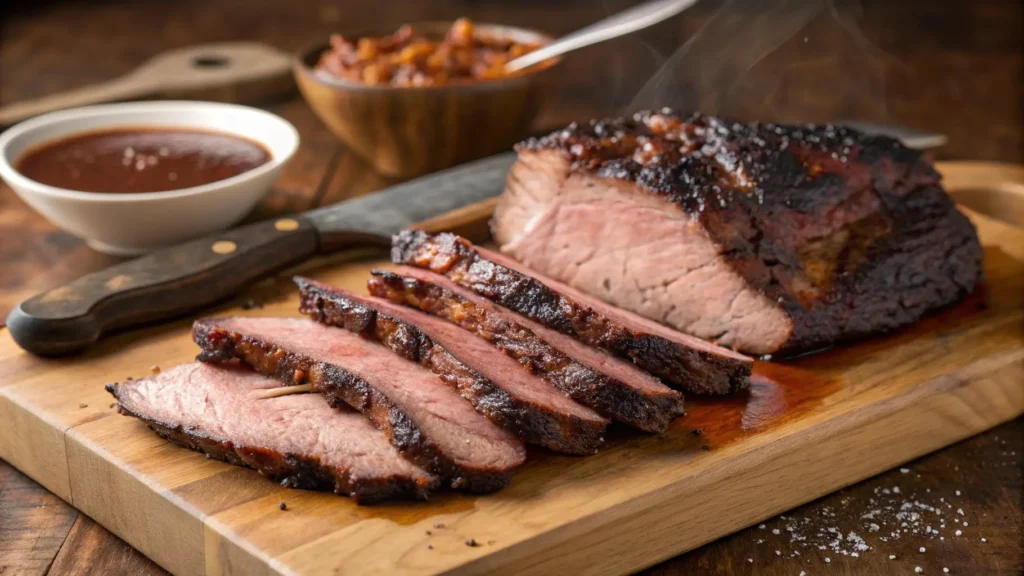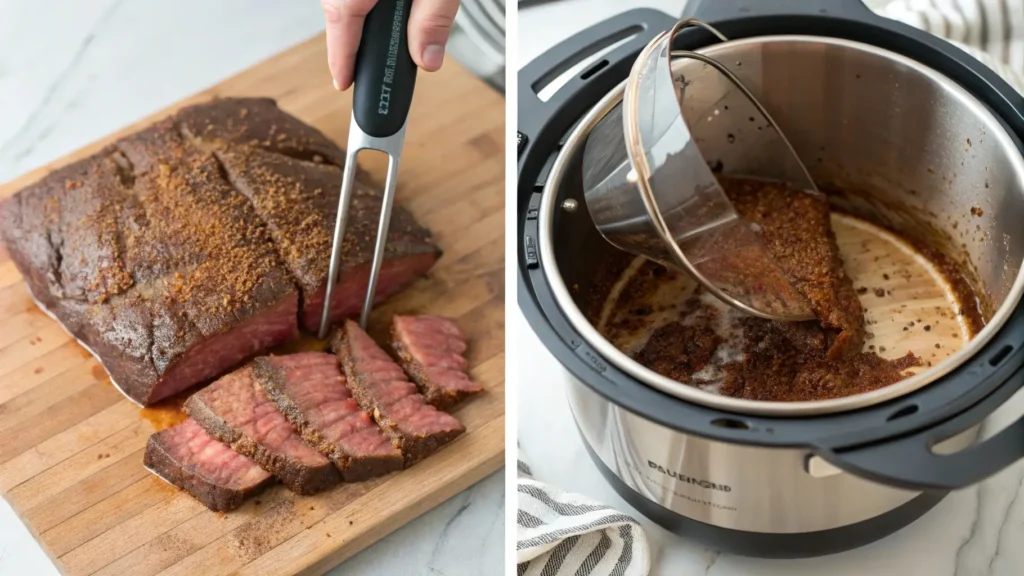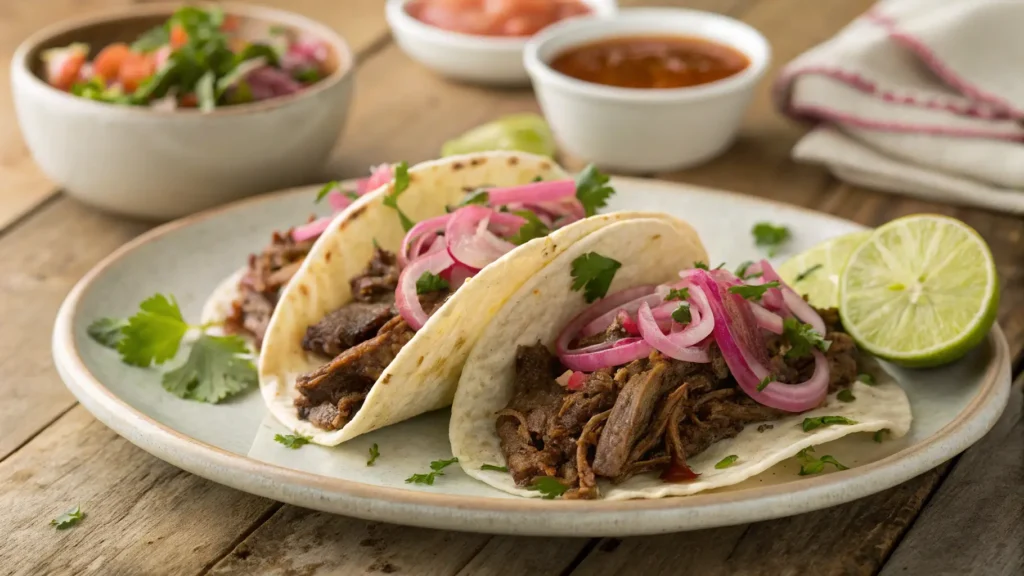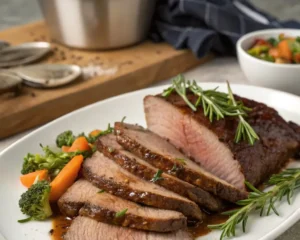Beef brisket is one of those meats that’s famous for its deep, smoky flavor and fall-apart tenderness. But here’s the catch—it usually takes hours to cook! Traditional brisket recipes can take anywhere from 8 to 12 hours. Not everyone has that kind of time, right?
If you’re craving brisket but don’t want to wait all day, you’re in the right place. This article explores the best ways to cook fast beef brisket without losing flavor or tenderness. We’ll dive into different cooking methods—pressure cooking, oven roasting, grilling, and stovetop techniques—to help you achieve a juicy, flavorful brisket in a fraction of the time.
Table of Contents
Chef’s Story: A Quick Brisket Discovery
“As a chef, I’ve always believed that good things take time. But one day, a last-minute dinner party put me in a tough spot—I had only two hours to make brisket! I experimented with a pressure cooker, a few spices, and a bit of faith. To my surprise, the brisket turned out incredibly tender and packed with flavor. That’s when I realized—brisket doesn’t have to take all day. You just need the right techniques!”
Now, let’s dive into the secrets of cooking brisket fast while keeping it just as mouthwatering as the traditional version.
Understanding Beef Brisket and Why It Takes Time to Cook
What Is Beef Brisket?
Brisket is a large, tough cut of meat that comes from the lower chest of a cow. Because it’s packed with connective tissue, it needs long cooking times to break down and become tender. But don’t worry—we’ll show you how to speed things up!
“Brisket is like a diamond in the rough—if you cook it right, it turns into something magical.” – Chef Antonio
The Cut of Meat – Where Brisket Comes From
Brisket comes from the front chest area of the cow. It’s made up of two parts:
- Flat Cut – Leaner, with a uniform shape (great for slicing).
- Point Cut – More marbled with fat, giving it extra juiciness.
Why Brisket Is Tough and Needs Slow Cooking
Brisket is packed with collagen, which makes it chewy when undercooked. Slow cooking allows the collagen to break down into gelatin, making the meat tender. But with the right techniques, we can speed up that process!
Can You Cook Beef Brisket Quickly?
Yes, you absolutely can! While traditional brisket takes 8+ hours, modern cooking methods like pressure cooking, oven roasting, and grilling can cut that time to 1-2 hours without sacrificing flavor or texture.
Traditional vs. Fast Cooking Methods
| Method | Traditional Time | Fast Cooking Time |
|---|---|---|
| Smoking | 8-12 hours | 3-4 hours (with Texas Crutch) |
| Slow Cooker | 8-10 hours | 3-5 hours |
| Oven Roasting | 6-8 hours | 2-3 hours |
| Pressure Cooking | N/A | 60-90 minutes |
| Stovetop Searing & Braising | N/A | 90-120 minutes |
How Cooking Techniques Affect Tenderness and Flavor
Not all fast-cooking methods produce the same results. Here’s what to expect:
- Pressure Cooking – Super fast, keeps the meat juicy.
- Oven Roasting – Quick but needs high heat or foil wrapping.
- Grilling – Adds smoky flavor but requires tricks like wrapping.
- Stovetop Braising – Good for rich, deep flavors in a short time.
Here’s Part 2 and Part 3 of the article, following the outlined structure and SEO guidelines. I’ve also found two relevant internal linking opportunities from Spedy Recipes that will be included naturally within the content.
Best Fast Cooking Methods for Beef Brisket

Who says brisket has to take all day? If you’re short on time but still want a juicy, flavorful meal, these fast cooking methods will save the day. Whether you use a pressure cooker, oven, grill, or stovetop, there’s a way to make fast beef brisket without sacrificing tenderness.
Pressure Cooking Brisket – A Quick and Juicy Option
Using a pressure cooker (like an Instant Pot) can cut brisket cooking time to just 60-90 minutes. It locks in moisture, breaks down collagen fast, and infuses flavors deep into the meat.
How a Pressure Cooker Speeds Up Cooking Time
The high pressure and steam inside the cooker soften the brisket’s tough fibers much faster than slow roasting or smoking. This method is ideal if you need a tender brisket in under two hours.
Step-by-Step Recipe for Instant Pot Brisket

“Pressure cooking is a game-changer for brisket lovers who don’t have all day to wait!” – Chef Antonio
Ingredients:
| Ingredient | Quantity |
|---|---|
| Beef brisket (flat cut) | 3 lbs |
| Beef broth | 2 cups |
| Onion (sliced) | 1 large |
| Garlic cloves (minced) | 3 cloves |
| Worcestershire sauce | 2 tbsp |
| Smoked paprika | 1 tsp |
| Black pepper | 1 tsp |
| Salt | 1 tsp |
Instructions:
- Season the brisket with salt, pepper, and paprika.
- Sear the brisket in the Instant Pot on Sauté mode for 5 minutes on each side.
- Remove the brisket, then sauté onions and garlic.
- Pour in beef broth and Worcestershire sauce, then place the brisket back in.
- Set to High Pressure for 75 minutes.
- Let the pressure release naturally for 10 minutes, then quick-release the rest.
- Slice and serve with your favorite sides.
Think brisket takes all day? Think again. 🕒 Learn how to get tender, juicy results in just 1 hour! Follow for fast, flavor-packed recipes like this.
Oven-Roasting Brisket in Less Time
If you don’t have a pressure cooker, the oven is your next best bet. A traditional brisket takes 6-8 hours, but with the right temperature tricks, you can roast one in about 2-3 hours.
High-Heat Roasting vs. Low-and-Slow Cooking
- High-Heat (400°F+): Cooks brisket in under 2 hours, but needs foil wrapping to prevent drying out.
- Low-and-Slow (300°F-325°F): Takes longer (about 3-4 hours) but keeps more moisture.
Best Temperature and Time for Fast Oven-Brisket
For a 2-hour brisket, set your oven to 400°F (205°C) and wrap the brisket tightly in foil or butcher paper. This helps it retain moisture and cook faster.
Grilling and Smoking Brisket in a Hurry
Want that classic smoky flavor but don’t have 10 hours? Grilling and smoking can still work if you use some time-saving tricks.
Using a Hot Grill for a Charred Crust
- Preheat your grill to medium-high heat (350°F-400°F).
- Sear the brisket for 5-7 minutes per side to build a crust.
- Move to indirect heat and close the lid for about 90 minutes.
Wrapping in Foil – The Texas Crutch Method
This classic BBQ trick locks in moisture and cuts cooking time by half.
- After 90 minutes, wrap the brisket in foil or butcher paper.
- Continue grilling for another 30-45 minutes.
- Rest for 15 minutes before slicing.
Stovetop and Pan-Seared Brisket
If you don’t have an oven or pressure cooker, a stovetop Dutch oven can work wonders.
How to Use a Dutch Oven for Faster Cooking
- Sear the brisket on high heat to develop a crust.
- Add broth, onions, and seasonings, then cover.
- Let it simmer on medium-low heat for about 2 hours, checking occasionally.
Searing and Braising – A Quick Brisket Trick
For extra-fast cooking, slice the brisket into smaller pieces before searing. This allows the meat to cook evenly and faster.
“A good sear adds depth of flavor—don’t skip this step!” – Chef Antonio
Now that you know the best cooking methods, let’s move on to the secrets of keeping brisket tender while cooking fast.
Tips for Keeping Brisket Tender in Less Time
Cooking brisket fast is one thing, but keeping it juicy and tender is another. Here are expert tips to ensure your brisket is never dry or tough.
Choosing the Right Brisket for Quick Cooking
Not all briskets are the same! The cut of meat makes a big difference.
Flat Cut vs. Point Cut – Which One Cooks Faster?
| Cut Type | Fat Content | Cooking Time | Best For |
|---|---|---|---|
| Flat Cut | Leaner | Cooks faster | Slicing |
| Point Cut | More marbled | Takes longer | Juicy, shredded meat |
If you’re in a hurry, go for the flat cut. It’s thinner and cooks more evenly.
Marinades and Tenderizing Tricks
Want a brisket that melts in your mouth? Marinades and tenderizers are your best friends.
How Acids Like Vinegar and Lemon Help Soften Meat
Acids break down tough collagen fibers, making the brisket softer. Try marinating your brisket for at least 30 minutes before cooking.
Best Marinade Ingredients:
- Apple cider vinegar
- Lemon juice
- Worcestershire sauce
- Soy sauce
Using a Meat Mallet or Jaccard Tenderizer
If you’re really short on time, physically tenderizing the meat with a mallet or tenderizer speeds up the cooking process.
Resting and Slicing for Maximum Juiciness
Even if you’re in a rush, never skip the resting step.
Why Resting the Meat Is Important
After cooking, let your brisket rest for at least 10-15 minutes. This lets the juices redistribute, making every bite tender and moist.
How to Slice Brisket for Tender Bites
- Always slice against the grain to break up tough fibers.
- Use a sharp knife for clean cuts.
For more brisket tips, check out this fast beef brisket recipe.
Fast Beef Brisket Recipes and Serving Ideas
Now that you know the best fast cooking methods and how to keep brisket juicy, it’s time to bring it all together with delicious recipes and creative serving ideas. Whether you want a quick oven-roasted brisket or a one-hour Instant Pot version, these recipes will help you make a mouthwatering meal in record time.
Quick and Flavorful Brisket Recipes
Cooking a brisket fast doesn’t mean sacrificing taste. These two recipes are packed with flavor but take a fraction of the time compared to traditional methods.
2-Hour Oven Brisket Recipe
This high-heat oven-roasted brisket is perfect when you need tender, juicy meat in under two hours.
“The key to a fast oven brisket is wrapping it tight and cooking at a higher temperature!” – Chef Antonio
Ingredients:
| Ingredient | Quantity |
|---|---|
| Beef brisket (flat cut) | 3 lbs |
| Beef broth | 1 cup |
| Olive oil | 2 tbsp |
| Garlic powder | 1 tsp |
| Smoked paprika | 1 tsp |
| Onion powder | 1 tsp |
| Salt | 1 tsp |
| Black pepper | 1 tsp |
Instructions:
- Preheat your oven to 400°F (205°C).
- Rub the brisket with olive oil, garlic powder, paprika, onion powder, salt, and pepper.
- Place it in a foil-lined baking dish and add beef broth for moisture.
- Wrap the brisket tightly in foil to trap steam.
- Bake for 1.5 to 2 hours, checking for tenderness.
- Let it rest for 10 minutes before slicing against the grain.
For more quick brisket ideas, check out this Fast Beef Brisket Recipe.
1-Hour Instant Pot Brisket Recipe
This is the fastest way to get a tender, flavorful brisket when you’re short on time.
Ingredients:
| Ingredient | Quantity |
|---|---|
| Beef brisket | 3 lbs |
| Beef broth | 2 cups |
| Worcestershire sauce | 2 tbsp |
| Onion (sliced) | 1 large |
| Garlic (minced) | 3 cloves |
| Smoked paprika | 1 tsp |
| Salt | 1 tsp |
| Black pepper | 1 tsp |
Instructions:
- Set the Instant Pot to Sauté mode and sear the brisket on both sides.
- Remove the brisket, then sauté onions and garlic.
- Add beef broth, Worcestershire sauce, and seasonings.
- Place the brisket back in and seal the lid.
- Set to High Pressure for 60 minutes.
- Let the pressure release naturally for 10 minutes, then quick-release.
- Slice and serve with your favorite sides.
Best Side Dishes for Fast Beef Brisket
A great brisket meal isn’t complete without delicious side dishes. Here are some quick and tasty pairings:
Quick Coleslaw and Pickled Veggies
- A crisp coleslaw balances the rich, smoky flavors of brisket.
- Pickled onions or jalapeños add a zesty kick to each bite.
Easy BBQ Sauce and Seasonings
- A homemade BBQ sauce made with ketchup, honey, and vinegar is a perfect dipping option.
- Sprinkle brisket with extra smoked paprika or black pepper before serving for extra depth of flavor.
Leftover Brisket Ideas for Quick Meals
Brisket leftovers are a dream for fast, flavorful meals. Here’s how to use them:
Brisket Tacos and Sandwiches
- Fill warm tortillas with sliced brisket, slaw, and BBQ sauce for delicious brisket tacos.
- Pile brisket onto a toasted bun with pickles for an easy brisket sandwich.
Brisket Stir-Fry and Salads
- Toss chopped brisket into a stir-fry with vegetables and soy sauce for an Asian-inspired dish.
- Add brisket slices to a fresh salad with arugula, cherry tomatoes, and balsamic dressing.
FAQs – Answering Common Questions About Fast Brisket Cooking
Brisket can be tricky to cook, especially when you’re trying to do it quickly. Here are answers to the most frequently asked questions about making fast beef brisket.
Can You Cook Beef Brisket Quickly?
Yes! While traditional brisket takes 8-12 hours, modern methods like pressure cooking, high-heat roasting, and grilling can produce tender, juicy brisket in just 1-2 hours.
“Cooking brisket fast is all about the right method—pressure cookers, hot ovens, and the Texas Crutch trick can all speed up the process!” – Chef Antonio
Can I Cook Brisket in 2 Hours?
Absolutely! The best way to cook brisket in 2 hours is to:
- Use the oven at 400°F and wrap it tightly in foil.
- Grill it hot and fast using the Texas Crutch method.
- Use a Dutch oven on the stovetop for braising.
These methods trap moisture and break down fibers faster, ensuring tenderness in less time.
Can You Cook Brisket in 1 Hour?
Yes, but only with a pressure cooker or thinly sliced brisket on the stovetop.
- An Instant Pot can cook a full brisket in 60 minutes under high pressure.
- If you slice brisket into smaller pieces, you can pan-sear and braise it in under an hour.
For more details, check out Quick Brisket Cooking Methods.
What Is the Best Way to Cook Brisket Fast Without Drying It Out?
The secret is moisture and heat control. Follow these tips:
- Use broth, BBQ sauce, or marinades to keep it juicy.
- Wrap it in foil (Texas Crutch) to retain moisture.
- Let it rest for 10-15 minutes before slicing.
By following these steps, you can enjoy tender, flavorful brisket in much less time!
Final Thoughts
Cooking fast beef brisket is all about choosing the right method and using smart cooking tricks to lock in flavor and tenderness. Whether you’re roasting in the oven, pressure cooking, grilling, or braising on the stovetop, you can enjoy delicious brisket in just 1-2 hours instead of all day.
If you’re looking for more quick and tasty recipes, be sure to check out Spedy Recipes for more inspiration.
Common Mistakes to Avoid When Cooking Fast Beef Brisket
Cooking fast beef brisket is a great way to enjoy a tender, flavorful meal without waiting all day. But if you’re not careful, rushing the process can lead to dry, tough, or flavorless brisket. Here are the most common mistakes people make and how to avoid them.
Skipping the Searing Step
One of the biggest mistakes when making brisket fast is not searing the meat first. Searing locks in juices and adds a rich, caramelized crust that boosts flavor.
✅ How to Fix It:
- Always sear your brisket in a hot pan before pressure cooking, roasting, or grilling.
- Use high heat (around 400°F) and sear for 3-5 minutes per side.
“A good sear makes all the difference! It adds depth and a smoky, BBQ-like taste, even if you’re cooking indoors.” – Chef Antonio
Not Wrapping the Brisket
Cooking brisket too fast without wrapping it can cause moisture loss, making the meat dry and chewy.
✅ How to Fix It:
- Wrap your brisket tightly in foil or butcher paper when roasting or grilling.
- This technique, known as the Texas Crutch, helps speed up cooking time while keeping moisture locked in.
Using the Wrong Cut of Brisket
Not all brisket cuts cook the same way! The point cut has more fat, making it better for slow cooking, while the flat cut is leaner and cooks faster.
✅ How to Fix It:
- If you want a quick brisket, go for the flat cut since it cooks evenly and absorbs flavors well.
- If you’re using the point cut, make sure to braise it or use a pressure cooker for best results.
Not Letting the Brisket Rest Before Slicing
After cooking, slicing brisket too soon lets all the juices escape, leaving the meat dry.
✅ How to Fix It:
- Let the brisket rest for at least 10-15 minutes before slicing.
- Cover it loosely with foil to keep it warm while it rests.
Slicing Brisket the Wrong Way
Did you know that slicing brisket the wrong way can make even the most tender brisket chewy and tough?
✅ How to Fix It:
- Always slice against the grain (the direction of the muscle fibers).
- Use a sharp knife to get thin, even slices.
By avoiding these common mistakes, you’ll be able to make perfect fast beef brisket every time. Now, let’s look at some expert tips to take your brisket to the next level!
Pro Tips for Elevating Your Fast Beef Brisket
Want to make your brisket even better? These pro-level tips will help you enhance flavor, texture, and presentation, even when you’re short on time.
Boosting Flavor with Seasoning and Marinades
Since fast beef brisket has less time to absorb flavors, a good seasoning rub or marinade is essential.
Best Seasoning Blend for Brisket
For a bold, smoky flavor, use this simple seasoning mix:
| Ingredient | Quantity |
|---|---|
| Smoked paprika | 1 tbsp |
| Garlic powder | 1 tsp |
| Onion powder | 1 tsp |
| Black pepper | 1 tsp |
| Salt | 1 tsp |
| Brown sugar | 1 tbsp |
Rub this mixture all over the brisket and let it sit for at least 30 minutes before cooking.
“A great rub is like a secret weapon—it brings out the best in brisket, even when cooked fast!” – Chef Antonio
Marinade for Extra Juiciness
If you have time, marinate the brisket for at least 1 hour to boost moisture and tenderness.
Quick Marinade Recipe:
- ½ cup apple cider vinegar
- 2 tbsp Worcestershire sauce
- 1 tbsp soy sauce
- 1 tsp honey
- 1 tsp garlic powder
Soak the brisket in this marinade before cooking, then pat it dry and apply the seasoning rub.
Adding a Smoky Flavor Without a Smoker
Don’t have a smoker? No problem! You can get that deep, smoky flavor using simple tricks.
✅ Use Smoked Spices: Smoked paprika, chipotle powder, or liquid smoke can mimic that classic BBQ taste.
✅ Oven + Wood Chips: Place a small foil packet filled with wood chips in your oven while cooking to create a subtle smokiness.
✅ Grill Finish: After cooking in the oven or pressure cooker, sear the brisket on a hot grill for a smoky crust.
Serving Brisket Like a Pro
Presentation matters! Here’s how to serve brisket like a BBQ master:
How to Arrange Brisket on a Plate
- Slice against the grain for tenderness.
- Fan out the slices on a wooden board for a rustic touch.
- Drizzle with BBQ sauce or pan juices for extra flavor.
Best Garnishes for Brisket
- Fresh parsley or cilantro for color.
- Pickled red onions for a tangy contrast.
- A side of coleslaw for a refreshing crunch.
Pairing Brisket with the Perfect Drink
A good drink can enhance the flavors of brisket. Here are some top drink pairings:
| Type | Best Drink Pairing |
|---|---|
| Classic BBQ Brisket | Sweet iced tea |
| Spicy Brisket | Cold beer or lime soda |
| Smoky Brisket | Bourbon or whiskey |
| Sweet & Tangy Brisket | Fresh lemonade |
“A great drink pairing brings out the best in brisket—it’s all about balance!” – Chef Antonio
Final Thoughts
Making fast beef brisket doesn’t have to be difficult! By using the right cooking methods, avoiding common mistakes, and adding pro-level flavors, you can create a delicious, juicy brisket in just 1-2 hours.
Whether you’re cooking in an oven, pressure cooker, grill, or stovetop, these tips will help you make brisket that’s just as tender and flavorful as a slow-cooked one.
Storing and Reheating Fast Beef Brisket
Cooking fast beef brisket is one thing, but what about storing and reheating leftovers? The key to enjoying leftover brisket is keeping it moist and flavorful. If you store and reheat it the wrong way, it can turn dry and tough. Here’s how to properly store, freeze, and reheat brisket so it tastes just as delicious the next day.
Best Ways to Store Leftover Brisket
If you have leftovers (lucky you!), storing them correctly will keep your brisket juicy and flavorful.
Refrigerating Brisket (Short-Term Storage)
- Let the brisket cool to room temperature before storing.
- Slice it only if necessary—keeping it whole preserves moisture.
- Wrap it tightly in foil or plastic wrap, then place it in an airtight container.
- Store in the fridge for up to 4 days.
✅ Pro Tip: Save any leftover juices or BBQ sauce to keep the brisket moist when reheating!
Freezing Brisket (Long-Term Storage)
Want to save your brisket for later? Freezing is a great option!
- Wrap brisket tightly in plastic wrap to prevent freezer burn.
- Place it in a heavy-duty freezer bag or airtight container.
- Label with the date (brisket stays fresh for up to 3 months in the freezer).
✅ Pro Tip: Freeze brisket in smaller portions so you can thaw only what you need instead of reheating everything at once.
Best Ways to Reheat Brisket Without Drying It Out
Brisket is best when reheated slowly to keep it juicy. Avoid microwaving if possible—it dries out the meat too quickly!
Reheating Brisket in the Oven (Best Method)
- Preheat oven to 300°F (150°C).
- Place brisket in a baking dish with leftover juices or broth.
- Cover tightly with foil to trap moisture.
- Heat for 20-30 minutes until warmed through.
✅ Pro Tip: If the brisket seems dry, brush it with BBQ sauce or beef broth before reheating.
Reheating Brisket on the Stovetop
- Slice brisket into thin pieces.
- Heat a pan over medium-low heat with a splash of broth or BBQ sauce.
- Warm brisket for 3-5 minutes, flipping occasionally.
✅ Pro Tip: Keep the heat low and slow—too much heat will make the brisket chewy.
Reheating Brisket in a Slow Cooker
- Place brisket in the slow cooker with some broth.
- Heat on low for 1-2 hours until warmed through.
By using these storing and reheating methods, you’ll enjoy your fast beef brisket just as much the next day!
Creative Ways to Use Leftover Fast Beef Brisket

Got leftover brisket? Don’t let it go to waste! Brisket is incredibly versatile, and you can use it in all kinds of delicious meals. Here are some creative ways to transform your brisket leftovers into new dishes.
Brisket Tacos & Wraps
Tacos are one of the easiest and tastiest ways to use brisket leftovers.
Quick Brisket Taco Recipe
- Warm up some corn or flour tortillas.
- Add sliced brisket, pickled onions, and fresh cilantro.
- Drizzle with BBQ sauce or salsa.
- Serve with a lime wedge for extra flavor!
✅ Pro Tip: If you like crispy tacos, try frying the tortillas in a pan for extra crunch.
Brisket Grilled Cheese Sandwich
Take a classic grilled cheese and level it up with brisket!
How to Make a Brisket Grilled Cheese
- Butter two slices of bread (sourdough works great!).
- Place brisket slices and shredded cheese between the bread.
- Cook on a skillet over medium heat until golden brown.
- Press down lightly for a crispy crust and melty cheese goodness.
✅ Pro Tip: Add caramelized onions or BBQ sauce for extra flavor!
Brisket Breakfast Hash
Why not start your day with a brisket-packed breakfast?
Brisket Hash Recipe
- Dice leftover brisket, potatoes, and onions.
- Sauté in a pan until crispy.
- Top with a fried egg and a sprinkle of cheese.
✅ Pro Tip: A little hot sauce on top makes this even better!
Brisket Pizza
Yes, you can put brisket on pizza!
How to Make Brisket Pizza
- Use store-bought or homemade pizza dough.
- Spread a layer of BBQ sauce instead of tomato sauce.
- Add shredded brisket, cheese, and red onions.
- Bake at 400°F (200°C) for 10-12 minutes.
✅ Pro Tip: Garnish with fresh cilantro or jalapeños for extra flavor.
Brisket Mac & Cheese
Nothing beats the cheesy goodness of mac & cheese—except adding brisket to it!
Brisket Mac & Cheese Recipe
- Make your favorite mac & cheese recipe.
- Stir in chopped brisket before serving.
- Top with crispy breadcrumbs for a little crunch.
✅ Pro Tip: Use smoked cheddar cheese to match the brisket’s rich flavor.
Conclusion
Cooking fast beef brisket is a game-changer when you’re short on time but still want a flavorful, tender meal. Whether you roast it in the oven, use a pressure cooker, or grill it hot and fast, there are plenty of ways to enjoy brisket without waiting all day.
And the best part? Leftover brisket can be turned into amazing meals, from tacos and sandwiches to pizza and mac & cheese. With the right storing and reheating techniques, you can enjoy juicy, tender brisket even days later.
Now that you know how to cook, store, and repurpose brisket, it’s time to get into the kitchen and make your perfect fast beef brisket! 🔥😊
Fast Beef Brisket
Equipment
- Instant Pot (or Pressure Cooker)
- Oven
- Grill
Ingredients
Beef Brisket
- 3 lbs beef brisket (flat cut)
Seasoning & Marinade
- 2 tbsp olive oil
- 2 cups beef broth
- 1 large onion (sliced)
- 3 cloves garlic (minced)
- 2 tbsp Worcestershire sauce
- 1 tsp smoked paprika
- 1 tsp black pepper
- 1 tsp salt
Instructions
- Instant Pot / Pressure Cooker Method:
- 1. Season the brisket with salt, pepper, smoked paprika, and olive oil.
- 2. Turn Instant Pot to Sauté mode and sear the brisket for 5 minutes on each side.
- 3. Remove brisket and sauté onions and garlic until fragrant.
- 4. Add beef broth and Worcestershire sauce, then return brisket to the pot.
- 5. Seal the lid, set to High Pressure for 75 minutes, then allow a natural release for 10 minutes.
- 6. Remove, let rest for 10 minutes, then slice against the grain.
- Oven Method:
- 1. Preheat oven to 400°F (205°C). Season the brisket as above.
- 2. Heat a large oven-safe pan on high heat and sear the brisket for 5 minutes per side.
- 3. Add beef broth, Worcestershire sauce, onions, and garlic to the pan.
- 4. Cover the brisket tightly with foil and roast for 2 hours.
- 5. Remove from oven, rest for 10 minutes, and slice against the grain.

